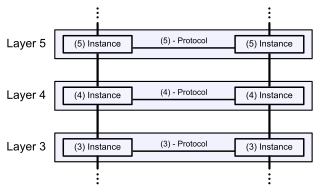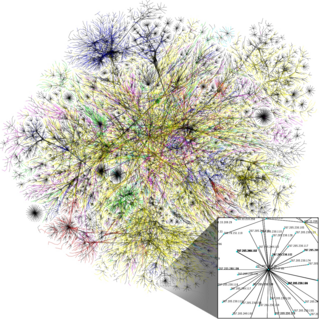The Lightweight Directory Access Protocol is an open, vendor-neutral, industry standard application protocol for accessing and maintaining distributed directory information services over an Internet Protocol (IP) network. Directory services play an important role in developing intranet and Internet applications by allowing the sharing of information about users, systems, networks, services, and applications throughout the network. As examples, directory services may provide any organized set of records, often with a hierarchical structure, such as a corporate email directory. Similarly, a telephone directory is a list of subscribers with an address and a phone number.

The Open Systems Interconnection model is a conceptual model that characterizes and standardizes the communication functions of a telecommunication or computing system without regard to its underlying internal structure and technology. Its goal is the interoperability of diverse communication systems with standard protocols. The model partitions a communication system into abstraction layers. The original version of the model defined seven layers.
The File Transfer Protocol (FTP) is a standard network protocol used for the transfer of computer files between a client and server on a computer network.
Computer telephony integration, also called computer–telephone integration or CTI, is a common name for any technology that allows interactions on a telephone and a computer to be integrated or coordinated. The term is predominantly used to describe desktop-based interaction for helping users be more efficient, though it can also refer to server-based functionality such as automatic call routing.
An application server is a software framework that provides both facilities to create web applications and a server environment to run them.
SIMPLE, the Session Initiation Protocol for Instant Messaging and Presence Leveraging Extensions, is an instant messaging (IM) and presence protocol suite based on Session Initiation Protocol (SIP) managed by the Internet Engineering Task Force. Contrary to the vast majority of IM and presence protocols used by software deployed today, SIMPLE is an open standard like XMPP.
In computer science, in particular networking, a session is a temporary and interactive information interchange between two or more communicating devices, or between a computer and user. A session is established at a certain point in time, and then ‘torn down’ - brought to an end - at some later point. An established communication session may involve more than one message in each direction. A session is typically stateful, meaning that at least one of the communicating parties needs to hold current state information and save information about the session history in order to be able to communicate, as opposed to stateless communication, where the communication consists of independent requests with responses.
Representational State Transfer (REST) is a software architectural style that defines a set of constraints to be used for creating Web services. Web services that conform to the REST architectural style, termed RESTful Web services (RWS), provide interoperability between computer systems on the Internet. RESTful Web services allow the requesting systems to access and manipulate textual representations of Web resources by using a uniform and predefined set of stateless operations. Other kinds of Web services, such as SOAP Web services, expose their own arbitrary sets of operations.
Call Control eXtensible Markup Language (CCXML) is an XML standard designed to provide asynchronous event-based telephony support to VoiceXML. Its current status is a W3C Proposed Recommendation, adopted May 10, 2011. Whereas VoiceXML is designed to provide a Voice User Interface to a voice browser, CCXML is designed to inform the voice browser how to handle the telephony control of the voice channel. The two XML applications are wholly separate and are not required by each other to be implemented - however, they have been designed with interoperability in mind
In computing, the X Window System is a network-transparent windowing system for bitmap displays. This article details the protocols and technical structure of X11.

Twisted is an event-driven network programming framework written in Python and licensed under the MIT License.

A VoIP phone or IP phone uses voice over IP technologies for placing and transmitting telephone calls over an IP network, such as the Internet, instead of the traditional public switched telephone network (PSTN).
A web framework (WF) or web application framework (WAF) is a software framework that is designed to support the development of web applications including web services, web resources, and web APIs. Web frameworks provide a standard way to build and deploy web applications on the World Wide Web. Web frameworks aim to automate the overhead associated with common activities performed in web development. For example, many web frameworks provide libraries for database access, templating frameworks, and session management, and they often promote code reuse. Although they often target development of dynamic web sites, they are also applicable to static websites.
In the X Window System, programs run as X clients, and as such they connect to the X display server, possibly via a computer network. Since the network may be accessible to other users, a method for forbidding access to programs run by users different from the one who is logged in is necessary.
A media server refers either to a dedicated computer appliance or to a specialized application software, ranging from an enterprise class machine providing video on demand, to, more commonly, a small personal computer or NAS for the home, dedicated for storing various digital media. This can also mean that these servers are specialized for media for streaming
Text over IP is a means of providing a real-time text (RTT) service that operates over IP-based networks. It complements Voice over IP (VoIP) and Video over IP.

The mobile switching station, abbreviated as MSC Server or MSS, is a 2G core network element which controls the network switching subsystem elements. Alternatively or adaptively, MSS can be used in GSM networks as well, if the manufacturer has implemented support for GSM networks in the MSS. Since an immediate upgrade of existing GSM network to 3G is not viable due to various issues like handset incompatibilities and high expenditure, most manufacturers do implement GSM support in MSS. In fact, MSS along with other 3G network elements such as media gateway (MGW), can be configured to support GSM network exclusively and can be considered as an upgraded version of existing GSM mobile switching centres. The MSC Server is standards-based and communicates with other distributed elements using industry open standards such as media gateway control protocol, megaco/H.248, session initiation protocol, M2UA and M3UA. The MSC server incorporates industry standards as defined by ETSI, ITU, GSM, 3GPP and 3GPP2 and other leading standard bodies. The MSS supports the regulatory environment set by governing bodies via its support for E911, CALEA/legal intercept, wireless and local number portability, TTY/TTD, and Number Pooling requirements.
IMS is a set of specifications to offer multimedia services through IP protocol. This makes it possible to incorporate all kinds of services, such as voice, multimedia and data, on an accessible platform through any Internet connection.
ASP.NET Web Forms is a web application framework and one of several programming models supported by the Microsoft ASP.NET technology. Web Forms applications can be written in any programming language which supports the Common Language Runtime, such as C# or Visual Basic. Main building blocks of Web Forms pages are server controls, which are reusable components responsible for rendering HTML markup and responding to events. A technique called view state is used to persist the state of server controls between normally stateless HTTP requests.




